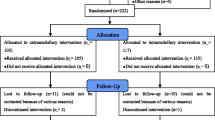Abstract
We report here the results of a retrospective study on 120 patients treated for transtrochanteric fractures of the femur using a minimally invasive technique with an extramedullary sliding pin as implant – which we denoted the MINUS System. The evaluation was carried out in in the postoperative period, and the levels of haemoglobin (Hb) and haematocrit (Ht), surgical time, radiological screening time and pain levels were recorded. Prior to the operation, mean Hb and Ht were 11.69 g/dl and 35.72%, respectively; in the immediate postoperative period, they were 10.35 g/dl and 32.4%, respectively. Mean operating time was 39.35 min. Average postoperative pain was assessed at 4.44 (on a scale of 1 to 10). The average time for screening was 1.07 min. Based on these criteria, we conclude that the minimally invasive technique of the MINUS System allows for a shorter operating time and a minimal blood loss in the treatment of transtrochanteric fractures of the femur.
Résumé
120 patients ont été opérés d’une fracture transtrochantérienne du fémur par technique mini invasive en utilisant une ostéosynthèse par une vis plaque (MINUS Système). Ces patients ont été analysés de façon rétrospective. L’évaluation a été analysée en post opératoire en prenant en considération le taux d’hémoglobine et l’hématocrite, le temps opératoire, le temps de scopie et la douleur. En préopératoire, le taux moyen d’hémoglobine et d’hématocrite sont respectivement de 11,69 g avec un hématocrite à 35,72%, en post opératoire le taux d’hémoglobine était à 10,35 g et l’hématocrite à 32,4%. Le temps moyen de l’intervention a été de 39,35 minutes. La douleur moyenne en post opératoire a été cotée à 4,44. Le temps moyen d’exposition aux rayons par scopie a été de 1,07 minutes. En conclusion, la technique d’ostéosynthèse par voie mini invasive utilisant le système MINUS permet de raccourcir le temps opératoire et d’économiser les pertes sanguines dans le traitement des fractures transtrochantériennes du fémur.







Similar content being viewed by others
References
Al-yassari G, Langstaff RJ, Jones JWM, Al-Lami M (2002) The AO/ASIF proximal femoral nail (PFN) for the treatment of unstable trochanteric femoral fracture. Injury 33:395–399
Baumgaertner MR, Curtin SL, Lindskog DM (1998) Intramedullary versus extramedullary fixation for the treatment of intertrochanteric hip fractures. Clin Orthop Relat Res 348:87–94
Baumgaertner MR, Curtin SL, Lindskog DM, Keggi J (1995) The value of the tip-apex distance in predicting failure of fixation of peritrochanteric fractures of the hip. J Bone Joint Surg 77-A(7):1058–1064
Bridle SH, Patel AD, Bircher M, Calvert PT (1991) Fixation of intertrochanteric fractures os the femur. A randomized prospective comparison os the gamma nail and the dinamic hip screw. J Bone Joint Surg [Br] 73-B:330–334
Bridle S, Patel A, Bircher M, Calvert PT (1991) Fixation of intertrochanteric fractures of the femur. J Bone Joint Surg [Br] 73:330–334
Cummings SR, Rubin SM, Black D (1990) The future of hip fractures in the United States: Numbers, costs, and potential effects of postmenopausal estrogen. Clin Ortop 252:163–166
Curtis MJ, Jinnah H, Wilson V, Cummingham BW (1994) Proximal femoral fractures: a biomechanical study to compare intramedullary and extramedulary fixation. Injury 25:99–104
Goldman L, Lee T, Rudd P (1983) Ten commandments for effective consultations. Arch Inter Med 143:1753–1755
Harrington P, Nihal A, Singhania AK, Howell FR (2002) Intramedullary hip screw versus slidind hip screw for unstable intertrochanteric femoral fractures in the elderly. Injury 33:23–28
Kaufer H (1980) Mechanics of the treatment of hip injures. Clin Orthop 146:53–61
Koval KJ, Aharonoff GB, Rokito AS, Lyon T, Zuckerman JD (1996) Patients with femoral neck and intertrochanteric fractures: are they the same? Clin Orthop 330:166–172
Koval KJ, Skovron ML, Aharonoff GB, Meadows SE, Zuckerman JD (1995) Ambulatory ability after hip fracture: a prospective study in geriatric patients. Clin Orthop 310:150–159
Lindskog DM, Baumgaertner MR (2004) Fraturas Intertrocantéricas Instáveis do Quadril em Idosos. J Am Acad Orthop Surg 12:179–190
Medoff RJ, Maes K (1991) A new device for the fixation os unstable pertrochanteric fractures of the hip. J Bone Joint Surg Am 73:1192–1199
Park SR, Kang JS, Kim HS, Lee WH, Kim YH (1998) Treatment of intertrochanteric fracture with the Gamme AP locking nail or by a compression hip scew – a randomized prospective trial. Int Orthop 22:157–160
Radford PJ, Needoff M, Webb JK (1993) A prospective randomized comparison of the dynamic hip screw and the gamma locking nail. Bone Joint Surg [Br] 75:789–793
Rockwood CH Jr (1993) Fraturas em adultos. Manole, Brazil
Ruedi TP, Murphy WM (2002) Placas em ponte, Princípios AO do Tratamento de Fratura, São Paulo. ArtMed Ed: 221–229
Rush LV (1968) Dynamic intramedulary fracture fixation of the femur. Reflexion on the use of the round rod after 30 years. Clin Orthop 60:21–27
Zain Elabdien BS, Olerud S, Karlstrom G (1984)The influence of age on the morphology of trochanteric fracture. Arch Orthop Trauma Surg 103:156–161
Author information
Authors and Affiliations
Corresponding author
Rights and permissions
About this article
Cite this article
Sawaia, R.N., Belangero, W.D. The treatment of transtrochanteric fractures of the femur with a minimally invasive technique using an extramedullary implant MINUS System. International Orthopaedics (SICO 32, 159–165 (2008). https://doi.org/10.1007/s00264-006-0304-7
Received:
Revised:
Accepted:
Published:
Issue Date:
DOI: https://doi.org/10.1007/s00264-006-0304-7




